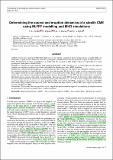Files in this item
Determining the source and eruption dynamics of a stealth CME using NLFFF modelling and MHD simulations
Item metadata
| dc.contributor.author | Yardley, Stephanie Louise | |
| dc.contributor.author | Pagano, Paolo | |
| dc.contributor.author | Mackay, Duncan Hendry | |
| dc.contributor.author | Upton, Lisa | |
| dc.date.accessioned | 2021-07-07T16:30:07Z | |
| dc.date.available | 2021-07-07T16:30:07Z | |
| dc.date.issued | 2021-08-27 | |
| dc.identifier | 273902061 | |
| dc.identifier | da98fff9-6c67-4bbb-b0e5-b610036239a7 | |
| dc.identifier | 000691922800006 | |
| dc.identifier | 85114210236 | |
| dc.identifier.citation | Yardley , S L , Pagano , P , Mackay , D H & Upton , L 2021 , ' Determining the source and eruption dynamics of a stealth CME using NLFFF modelling and MHD simulations ' , Astronomy & Astrophysics , vol. 652 , A160 . https://doi.org/10.1051/0004-6361/202141142 | en |
| dc.identifier.issn | 0004-6361 | |
| dc.identifier.other | ORCID: /0000-0001-6065-8531/work/100172535 | |
| dc.identifier.uri | https://hdl.handle.net/10023/23489 | |
| dc.description | Funding: S.L.Y. would like to acknowledge STFC for support via the consolidated grant SMC1/YST037 and alsoNERC for funding via the SWIMMR Aviation Risk Modelling (SWARM) Project, grant number NE/V002899/1. P.P.would like to thank the ERC for support via grant No. 647214. D.H.M. would like to thank the STFC for support via consolidated grant ST/N000609/1 and, the Leverhulme trust, and the ERC under the Synergy Grant: The Whole Sun (grant agreement no. 810218) for financial support. P.P. and D.H.M. would like to thank STFC for IAA funding under grant number SMC1-XAS012. L.A.U. was supported by the NSF Atmospheric and Geospace Sciences Postdoctoral Research Fellowship Program (Award AGS-1624438). | en |
| dc.description.abstract | Context. Coronal mass ejections (CMEs) that exhibit weak or no eruption signatures in the low corona, known as stealth CMEs, are problematic as upon arrival at Earth they can lead to geomagnetic disturbances that were not predicted by space weather forecasters. Aims. We investigate the origin and eruption of a stealth event that occurred on 2015 January 3 that was responsible for a strong geomagnetic storm upon its arrival at Earth. Methods. To simulate the coronal magnetic field and plasma parameters of the eruption we use a coupled approach. This approach combines an evolutionary nonlinear force-free field model of the global corona with a MHD simulation. Results. The combined simulation approach accurately reproduces the stealth event and suggests that sympathetic eruptions occur. In the combined simulation we found that three flux ropes form and then erupt. The first two flux ropes, which are connected to a large AR complex behind the east limb, erupt first producing two near-simultaneous CMEs. These CMEs are closely followed by a third, weaker flux rope eruption in the simulation that originated between the periphery of AR 12252 and the southern polar coronal hole. The third eruption coincides with a faint coronal dimming, which appears in the SDO/AIA 211 Å observations, that is attributed as the source responsible for the stealth event and later the geomagnetic disturbance at 1 AU. The incorrect interpretation of the stealth event being linked to the occurrence of a single partial halo CME observed by LASCO/C2 is mainly due to the lack of STEREO observations being available at the time of the CMEs. The simulation also shows that the LASCO CME is not a single event but rather two near-simultaneous CMEs. Conclusions. These results show the significance of the coupled data-driven simulation approach in interpreting the eruption and that an operational L5 mission is crucial for space weather forecasting | |
| dc.format.extent | 15 | |
| dc.format.extent | 10982646 | |
| dc.language.iso | eng | |
| dc.relation.ispartof | Astronomy & Astrophysics | en |
| dc.subject | Magnetohydrodynamics (MHD) | en |
| dc.subject | Sun: coronal mass ejections (CMEs) | en |
| dc.subject | Sun: magnetic fields | en |
| dc.subject | Methods: data analysis | en |
| dc.subject | QB Astronomy | en |
| dc.subject | QC Physics | en |
| dc.subject | 3rd-DAS | en |
| dc.subject.lcc | QB | en |
| dc.subject.lcc | QC | en |
| dc.title | Determining the source and eruption dynamics of a stealth CME using NLFFF modelling and MHD simulations | en |
| dc.type | Journal article | en |
| dc.contributor.sponsor | Science & Technology Facilities Council | en |
| dc.contributor.sponsor | European Research Council | en |
| dc.contributor.institution | University of St Andrews. Applied Mathematics | en |
| dc.identifier.doi | https://doi.org/10.1051/0004-6361/202141142 | |
| dc.description.status | Peer reviewed | en |
| dc.identifier.grantnumber | ST/S000402/1 | en |
| dc.identifier.grantnumber | 810218 | en |
This item appears in the following Collection(s)
Items in the St Andrews Research Repository are protected by copyright, with all rights reserved, unless otherwise indicated.

